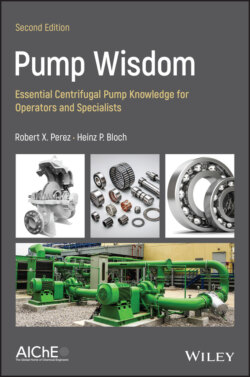Читать книгу Pump Wisdom - Robert X. Perez - Страница 10
Оглавление
Preface
In the 10 years since the first edition of this book was compiled, upgrading in accordance with this text was largely practiced by a few best‐in‐class performers (“BiCs”). The feedback from these fluid machinery users was very gratifying and the publishers expressed interest in a second, expanded Edition. Robert Perez was asked to join the two‐man writing team and the results are found in this updated Second Edition text. True to the subtitle we selected, you will find this volume to contain Essential Centrifugal Pump Knowledge for Operators and Specialists.
Next to electric motors, centrifugal pumps are the most frequent rotating machine man has built and put to use. Centrifugal pump users have access to hundreds of books and many thousands of articles dealing with pump subjects. So, one might ask, why do we need this text? We co‐authors are certain that we need this text because an unacceptably large number of centrifugal process pumps fail catastrophically every year. An estimated 95% of these are repeat failures and most of them are quite costly, or dangerous, or both.
Essentials concentrate on explaining the many elusive failure causes that manifest themselves as repeat failures. We saw it as our mandate and task to clearly map out permanent remedial action. Our intent was to steer clear of the usual consultant‐conceived generalities and give you tangible, factual, and well‐defined information throughout.
As any close review of what has been offered in the past will uncover, many texts were written to primarily benefit one particular job function, ranging from centrifugal pump operators to pump designers. Some books contain a hidden bias, or they appeal to a very narrow spectrum of readers; others are perhaps influenced by a particular centrifugal pump manufacturer’s agenda. Give this text a chance, you will see that it is different. You will not find it in other texts. We gave it the title Pump Wisdom because wisdom is defined as applied knowledge. If you concur with this very meaningful definition you will be ready for a rather serious challenge. That challenge is to practice wisdom by acting on the unique knowledge this text conveys.
Although both of us had written or co‐authored other books and dozens of articles on centrifugal pump reliability improvement, some important material is too widely dispersed to be readily accessible. Moreover, some important material has never been published before. We again set out to assemble, rework, condense, and explain the most valuable points in a text aimed at ever wider distribution. With the addition of troubleshooting material, coverage of sensors, and centrifugal pump surveillance topics, it is now a text with, we hope, even more permanence and “staying power” than its predecessor edition. To thus satisfy the scope and intent of this book, we stayed with our original intention to keep theoretical explanations to a reasonable minimum and to limit the narrative to about 250 pages. Putting it another way, we wanted to squeeze into these 250 pages material and topics that will greatly enhance both centrifugal pump safety and reliability. All that is needed is the reader's solid determination to pay close attention and to follow up diligently.
Please again realize that in years past, many centrifugal pump manufacturers have primarily concentrated their design and improvement focus on the hydraulic end. Indeed, over time and in the decades since 1960, much advancement has been made in the metallurgical and power efficiency‐related performance of the hydraulic assembly. Meanwhile, the mechanical assembly or drive‐end of centrifugal process pumps was being treated with relative indifference. In essence, there was an imbalance between the attention given to pump hydraulics and pump mechanical issues.
Recognizing indifference as costly, this text will indeed rectify some of these imbalances. Our narrative and illustrations are intended to do justice to both the hydraulic assembly and the mechanical assembly of centrifugal process pumps. That said, the book briefly lays out how centrifugal pumps function and quickly moves to guidelines and details that must be considered by reliability‐focused readers. A number of risky omissions or shortcuts by centrifugal pump designers, manufacturers, and users are also described.
The co‐authors are indebted to AESSEAL. A worldwide manufacturer of sealing products, the company was unselfish in providing many images and special artwork without making us wait for the approval of layers of bureaucracy which, in a number of other instances, has delayed or even prevented the move to more reliable pump products. The company has demonstrated an exemplary respect for the environment and is often considered as an example of how a business should conduct itself for the mutual benefit of all parties.
Please take from us a strong measure of encouragement: Make good use of this book. Read it and apply it. Today, and hopefully years from now, remember to consult this material. Doing so will acquaint you and your successors with centrifugal pump failure avoidance and the more elusive aspects of preserving pump‐related assets. And so, while you undoubtedly have more problems than you deserve, please keep in mind that you also deserve access to more solutions than you previously knew about or presently apply. Sound solutions are available, and they are here, right at your fingertips. Use them wisely; they will be cost‐effective. The solutions you can discern from this text will have a positive effect on centrifugal pump safety performance and asset preservation. They have worked at Best‐of‐Class companies and cannot possibly disappoint you.
Robert X. Perez, P.E., and Heinz P. Bloch, P.E.
Fall 2020
